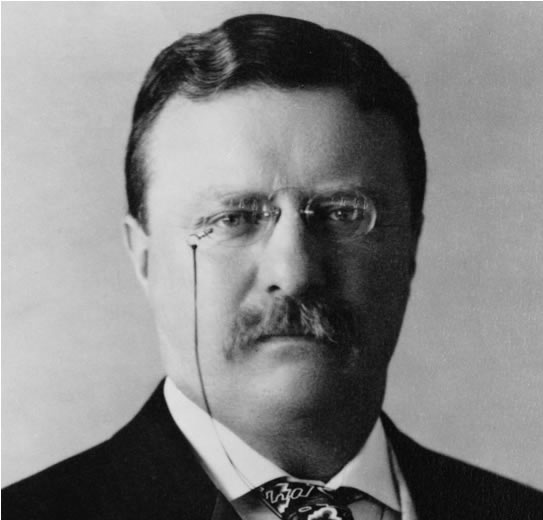Theodore Roosevelt |
|||||
 |
|||||
Theodore Roosevelt was born on October 27th, 1858 in New York City. In 1880, he graduated from Harvard University and enrolled in Columbia University's school of law. His political career began in 1882 in the New York State Assembly. In 1886, after spending three years at his North Dakota ranch, he returned to New York City and ran unsuccessfully for mayor. Nevertheless, his political career continued to blossom. In 1889, he was appointed to the U.S. Civil Service Commission by President Benjamin Harrison for which he served six years. In 1895, he became president of the New York City Board of Police Commissioners. Two years later, in 1897, he was appointed assistant secretary of the Navy by President William McKinley. In 1898, in the wake of the U.S. war with Spain, Teddy Roosevelt resigned from the Navy and organized the first regiment U.S. volunteer cavalry, known as "Roosevelt's Rough Riders". The "Rough Riders" were 2,000 specially selected men of different occupations and backgrounds trained by Roosevelt in San Antonio, Texas for special combat against the Spanish in Cuba. On June 20th, 1898, the "Rough Riders" left for Cuba. They landed at Daiquiri, Cuba and fought their way toward the Spanish garrison at Santiago. As they approached Santiago, the "Rough Riders" were attacked at San Juan Hill. Despite vigorous resistance from the Spanish, and mounting casualties, the "Rough Riders" charged up San Juan Hill, drove back the Spanish, and forced them to surrender, effectively ending the war. Teddy Roosevelt was a national hero! In 1899, after the Spanish-American War, Theodore Roosevelt was elected governor of New York. Soon after, in 1900, he was nominated as vice presidential candidate on the Republican ticket. In 1901, he was inaugurated as William McKinley's vice president. Roosevelt, however, would occupy the office of vice president for only a short time. Merely six months after becoming vice president, President William McKinley was assassinated in Buffalo, NY. On September 14, 1901, Theodore Roosevelt was sworn in as America's 26th president. At the time he took office, he was the youngest president in the history of the United States. Theodore Roosevelt served two eventful terms as president. In his first term, he supported a rebellion in Panama that cleared the way for that country's independence from Colombia, as well as for the U.S. acquisition of land in Panama that would later be used for construction of the Panama Canal. He fought vigorously against corporate corruption, and pushed for the dissolution of the Northern Securities Company for violating the Sherman Antitrust Act (forming a monopoly). In 1905, President Roosevelt helped mediate a peace treaty between Russia and Japan for which he was awarded the Nobel Peace Prize. In 1906, Roosevelt signed the Hepburn Act, which awarded greater powers to the Interstate Commerce Commission and the Federal Food and Drug Act. Furthermore, Roosevelt started the U.S. Forest Service and signed the 1906 Antiquities Act under which he proclaimed 18 national monuments, 5 national parks, 51 wildlife refuges and 150 national forests. In 1908, the Bureau of Investigation was created to conduct investigations for the Justice Department. After his second term as president, Teddy spent the rest of his life exploring and hunting. He died June 4th, 1918. Theodore Roosevelt National Park, in the Badlands of North Dakota, was dedicated after his death. Roosevelt was one of four presidents rendered on Mount Rushmore in South Dakota. |
|||||
Full Presidential Biographies |
|||||
| Click a president to learn more! | |||||
 |
 |
 |
 |
 |
 |
 |
 |
 |
 |
 |
 |
 |
 |
 |
 |
 |
 |
 |
 |
 |
 |
 |
 |
 |
 |
 |
 |
 |
 |
 |
 |
 |
 |
 |
 |
 |
 |
 |
 |
 |
 |
 |
 |
||||